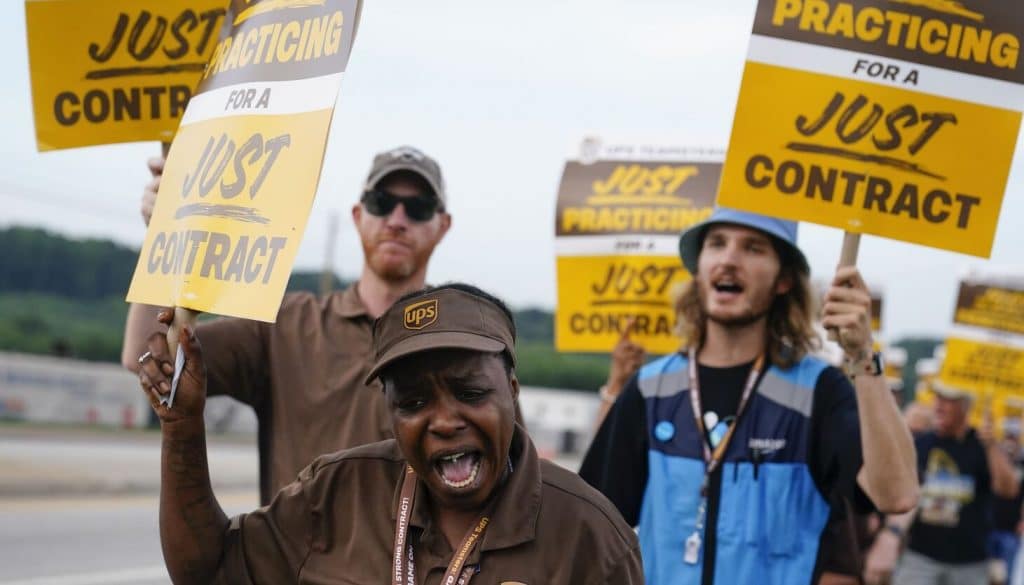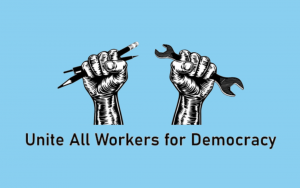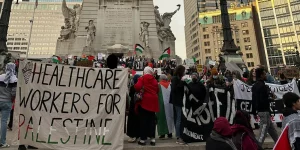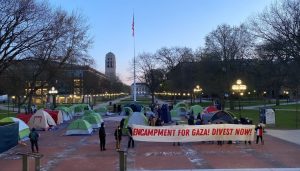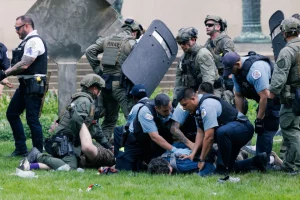On Tuesday afternoon, Teamsters announced the outcome of the vote on the proposed tentative agreement at UPS. Of the more than 150,000 members who voted, an overwhelming majority, 86 percent, voted in favor of the proposed agreement.
While this contract has important gains, more could have been won by going on strike, which UPS workers were ready to do. These results, and the larger contract struggle at UPS, show both the strengths and the weaknesses of the burgeoning new labor movement in the United States.
The contract struggle at UPS, one of the largest logistics sector employers in the United States, captured the hearts and imaginations of working people across the country, demonstrating the shifts in working-class consciousness that have raised worker expectations after the pandemic. It also showed clearly that workers are increasingly willing to fight and to strike in order to win their demands. Rank-and-file Teamsters voted overwhelmingly to authorize a strike, and thousands took part in practice pickets before the contract deadline. This energy and commitment played an important role in pushing UPS to offer concessions to the Teamsters, particularly helping to roll back several anti-worker measures that the company had succeeded in ramming through in the last contract.
At the same time, the contract agreement highlights the limits of the current labor movement. Despite all the strength of a possible strike, with the winds blowing in the favor of UPS workers, including massive popular support, union leaders were able to convince the vast majority of workers not to strike and to accept a contract that failed to resolve key issues and that even the CEO of UPS, Carol Tomé, characterized as a “win-win-win.”
This scenario demonstrates the ongoing need to build rank-and-file power and self-organization in order to challenge the failed conciliatory politics of the union bureaucracies, and to help the labor movement break from the Democratic Party.
Missed Opportunities
After decades of neoliberal austerity and declining working standards for UPS workers — especially for part timers like me — there were immense possibilities for workers to raise their heads and their fists to demand more. And in a moment when there are still over 140,000 workers on strike between the WGA and SAG-AFTRA and we are a few weeks away from the deadline for the UAW auto workers’ negotiations, the prospect of 340,000 UPS workers going on strike had the potential to reinvigorate the workers’ movement.
In this grand theater of collective action, if UPS workers had gone on strike, they would not only have disrupted the company’s operations — they would have also sent shockwaves through the economy and the supply chain, highlighting that we are the ones who actually run society. It would have occurred right before the negotiations for the Big Three automakers — and a strike and a victory, or an ongoing strike at UPS, would have raised the standards and combativeness of these workers. A possible UPS strike had the potential to unite our union and bridge the massive wage gap between drivers and part timers, offering an opportunity to act together for the most exploited sectors of our union. It is not an exaggeration to wonder if this could have been the spark to ignite a fire in the U.S. labor movement.
On July 25, just a few days before the strike deadline, a tentative agreement was reached between UPS and the Teamsters. Before the full contract language was even out for workers to see, Democratic Party politicians were touting the contract as a massive victory. This contract has important gains that are a product of the mobilizing and organizing of rank and file workers. However, although the contract has been approved by a majority (86% of 156,099 votes), it still left many UPS workers like myself feeling that it fell short of the historic contract we had envisioned.
The prevailing sentiment among the vote no campaign, and also in large sections of the yes vote too, is that “we could have fought for more.” This sentiment speaks volumes about the shifting dynamics within the labor force; workers’ expectations are higher than ever. It also highlights what will be needed to create a fighting labor movement that does not call on workers to lower our expectations, but strengthens us to organize ourselves to demand, fight, and strike.
We Had the Momentum for a Strike
Jane McAlevey wrote in The Nation regarding the UPS bargaining:
As a movement, we need to remain sharply aware of moments when we have sufficient leverage to set new standards and pay it forward, rather than limiting ourselves to restoring previous gains…UPS workers right now are in a strategically advantageous position, coming out of the height of the pandemic with UPS reporting record-shattering profits, while shareholders and the CEO gorge on the money made by an exhausted rank and file whose sweat and suffering earned the bosses that money—and with the country as a whole facing a tight labor market, and massive pro-worker and anti–greedy CEO sentiment flaring up with each strike workers are waging in sector after sector.
On this point, she is right.
The company has experienced substantial growth since 1997, with a larger workforce, annual profits exceeding $10 billion each of the last three years, our hands alone contribute to moving 6 percent of the U.S. GDP which includes the daily movement of over 20 million packages. UPS was under tremendous pressure. A strike could have translated into billions in losses, and a damage to its image as conversations centered around our precarious working conditions, especially for part-time employees. The company was backed into a corner.
There was a distinct momentum: we emerged from the pandemic as essential workers, recognized as agents of change within the working class. There is hatred against the corporations and CEOs who enriched themselves during the pandemic. Hundreds of thousands of workers across the country were on strike while the contract negotiations were going on. Union popularity continued to grow, especially among the youth, who played pivotal roles in organizing at places like Starbucks, Amazon, and others. We reached this point after a year-long campaign that climaxed with a 97 percent vote in favor of striking, practice pickets held across the country, and a workforce ready to strike on August 1. As ten-year Detroit Teamster Emily Butt said in a Jacobin podcast: “I don’t feel we were given the opportunity for a full fight. We were told that negotiating is a full contact sport, […] and we never got to fight.”
We could have joined the strikes going on and reached the half a million strong on strike, inspiring numerous other sectors to follow suit. Workers across the country had ample reasons to push back, as our working conditions and wages had been eroded by economic crises, the pandemic, inflation, and profit-driven corporations.
American historian Nelson Lichtenstein, speaking about the aftermath of the UPS 1997 strike, mentioned how it put an end to the “the PATCO syndrome, a sixteen-year period in which a strike was synonymous with defeat and demoralization.” 26 years later, could this possible UPS strike have played again a major role in to create a positive inflection point in the labor movement as a whole? I don’t think it’s an exaggeration to posit that it might have.
It could have influenced UAW negotiations and the SAG and WGA strikes; it could have shown working people everywhere how workers can shut down society. Such a demonstration of worker power had the potential to reinvigorate and radicalize the new labor movement that has entered onto the scene since the pandemic.
As Joe Allen said at an event organized by Tempest and Left Voice:
The big winner I think in the contract right now, the TA, is the Joe Biden administration which has continued its role — much more covertly this time — trying to prevent major national strikes of major economic significance … They used more behind the scenes politics to make sure there wasn’t a strike this year. So the Biden’s administration is getting pretty much everything they wanted.
The Biden administration, already in election mode, sought to avoid a strike that could disrupt the supply chain and mobilize the working class onto the streets. We already saw how Biden interrupted the railway strike, and Biden, of course, wanted to avert this possibly disruptive strike. If there is something that the government doesn’t want, it is to have the working class also gaining popularity using their own class struggle methods to find solutions to daily political, social and economic problems. O’Brien already expressed approval for President Joe Biden’s involvement in the railroad worker’s contract negotiations and encouraged members of the Teamster rail union to embrace the tentative agreement, even though it was not well-received.
The union leadership averted a possible confrontation/experience of workers with the Democratic Party, since for all of the lip service of this administration as “the most pro-labor administration,” it shows day after day that it defends the interests of the bosses, not workers. That’s another aspect of Biden’s victory with this contract.
The TA’s Shortcomings
There are real gains in the contract that have been won through organizing, such as getting rid of the 22.4 classification, which means eliminating the most egregious aspects of the two-tier system among drivers. It also gets rid of the forced “sixth punch,” wherein workers can be forced to come in on a sixth day and work overtime. Newly-purchased trucks will have air conditioning, and Martin Luther King, Jr. Day will become a paid holiday.
But, there are major shortcomings, for both drivers and part timers, as we have described (for more on the shortcomings on the contract, read this and this). This includes maintaining a four year progression for drivers to reach higher wages, as well as very weak enforcement mechanisms for overtime and a lack of air conditioning in warehouses, as well as in most trucks. And there are more issues, like not enough pension increases and catch-up raises, surveillance cameras in cars deactivated but still inside the cars, personal vehicle drivers (PVDs) and outsourcing restricted but still allowed, among others. But the biggest issue is the way this contract continues the massive rift between part timers and full timers.
“Part-Time America” Still Won’t Work
A lot of the discussion around part-timers has been intentionally focused on wages but little has been spoken about our working conditions more generally. In 1978, Teamsters for a Democratic Union (TDU) put out a brochure that called for equal pay and a five hour-a-day guarantee for part-timers. Twenty five years later, part-timers are only guaranteed 3.5 hours a day, and there was no discussion to increase it. Today, being paid $21 an hour only secures $367 per week before taxes. This is still poverty wages.
As I mentioned in a previous article:
When examining historical wage trends, the entry-level wage for an hourly employee at UPS in 1982 was $8 per hour, which, when adjusted for inflation, equates to approximately $25 today. However, the creation of a tiered system within UPS has resulted in a stark wage gap between part-time and full-time workers, undermining the significance of hours worked as the main differentiating factor.”
This increasing wage gap reflected a larger pattern under neoliberalism, which created a sector of lower tier workers — disproportionately Black and Brown — who make poverty wages.
One of the major complaints of my co-workers is that we don’t get enough hours. The company will always try to push workers to get all the work done in 3.5 hours, which causes a huge physical and mental toll on workers, especially in the summers, which have become increasingly hotter and unbearable each year. UPS’s disdain for inside workers is so strong that it took a strike threat to get more water, ice, and fans for workers inside the warehouses in the midst of a heat wave and a changing climate that will only get hotter. There was no discussion of having AC at the warehouses, which means that for the next 5 years, part-timers will have to continue working under grueling conditions and extreme heat.
Ten-minute breaks are not enough. We barely have time to use the restroom and get something to drink or eat. In peak season or busier weeks, like at the end of July, we worked closer to 5 hours every day, in a historic record heat, and again, we only got 10 minutes to rest from the grueling work. UPS doesn’t care about our health and livelihood; for them, we are just a disposable, cheap labor force.
In this contract campaign, the TDU circulated a brochure and a petition demanding $25 an hour and longer breaks for part timers. But as the contract campaign continued, that demand was totally left behind: it was taken down from their website and materials. And when the tentative agreement came out, this supposedly left caucus within the Teamsters did not bring up the $25 demand. Concessions are not only things that go backward, but also fights that are not put up, like all these immediate needs for part-timers. The long history of concessions and leaving behind the part-timers, plus the constant turnover, made our sector feel disconnected and disengaged with the union.
In the absence of a clear demand for a liveable wage for part timers, the bar was lowered for the entire sector. When part timers evaluated the TA, it was now not in the context of a demand for a higher wage, but in comparison to the present unlivable wage — making an inch or a foot look like a mile. All of this skews negotiations in favor of the bosses, who can continue the profitable trend of squeezing the most exploited sector of workers.
I get up for work at 3 am, with intense back pain from working this job, and deeply exhausted from working at UPS and various additional gigs to make ends meet. With this contract, there is no substantive change in my life. It doesn’t feel historic. I get better pay, but not enough to make ends meet. I get two more sick days, which as I reflect on the pain in my back, I know isn’t enough. I can only imagine what it feels like for single parents who not only need to struggle to make ends meet for themselves, but also for their children. I think about the parents who can’t even pick up their kids due to back aches and who cannot take days off to care for kids when they get sick.
Until 1982, UPS employees working inside the hubs were full-time workers who received wages comparable to those of full-time workers. When part-time positions were created, the starting wage was equivalent to over $25 an hour in 2023 dollars, adjusted for inflation. Today, $25 an hour should be the bare minimum.
Many of my coworkers said they planned to vote no, but many others said they were voting yes, largely to secure the $21 starting wages, which they so desperately need to survive. Putting out the TA to a vote in the way it was done sparked many divisions between sectors who are more satisfied than others. Many workers who wanted to fight for more feared that a vote no could jeopardize what had been gained in the TA, an illusion fostered by union leaders. It was certainly possible to organize workers to discuss the TA and its shortcomings, have more practice pickets and more parking lot meetings, which would show to UPS that workers wanted a better deal.
The contract has been hailed as a “historic win” by union leaders and Democratic Party politicians, and the press is making huge efforts to highlight the new $49 an hour top rate for drivers to show that the UPS workforce is already getting a lot of money. The union’s massive vote yes campaign, which included social media, flyers, text messages, and the direct targeting of people who were speaking in favor of a no vote, as well as the total lack of space for debate, created a situation where part-timers found it difficult to prioritize their demands. With few opportunities to really strategize and discuss other options, they were unable to see the benefits of continuing to fight and were afraid to lose what little they felt they had already gained.
When you depend on multiple jobs and you have to count every penny, it’s very hard to take risks when the union leaders are telling you this is the best you’re gonna get. What the 85 percent number does not show is that for many, it was a begrudging “yes” vote out of uncertainty and urgent need. While the IBT and Sean O’Brien claim they ended poverty wages, the way that part-time work is structured at UPS makes us continue living with a low income. This setup will continue at least for another 5 long years until a new contract is negotiated.
A TA Negotiated by Members For Members?
The Teamsters union leadership has been saying that this has been the most transparent and democratic negotiation in a long time. Of course, any comparison to Hoffa’s legacy is not so hard to improve. But they have been claiming that this is what a democratic union looks like, and that’s just not true.
To begin with, the O’Brien leadership agreed to go through the negotiations with a non-disclosure agreement (NDA). Workers were kept in the dark until each specific agreement was reached and an update was made. This is far from democratic: negotiations should be open to each and every worker to watch and discuss the next steps.
It is true that O’Brien regularly provided updates, social media communication, and webinars. But that is not enough, and we should not mistake that for union democracy.
In the case of part timers, we had no idea what was being negotiated “on our behalf.” How much were they asking for our wage increases? Were they fighting for longer breaks for us? We had no idea. We found out what was on the table for us the same day that the TA was reached. How can we organize part-time workers and get ready to strike if we don’t know what are the specific demands we are fighting for?
The same logic applies for parking lot meetings — Teamster meetings held at the end of shifts in parking lots as workers are getting ready to go home. In a contract negotiation period, this should happen very often in order to share information in real time and get feedback from workers on the spot, who can then vote for proposals. Having debates during thousands of regular parking lot meetings would have made the process more democratic and participatory. Instead, most of the rallies and parking lot meetings were mainly speeches and updates — we weren’t able to respond with our thoughts or ideas.
All this was exacerbated at the time of the vote. The IBT used all its apparatus (including the support of the Democratic Party public figures) to push workers to vote yes. When they realized the “historic contract” discourse was not enough and certain discontent was being expressed among the rank-and-file, they increased their media push for the contract. There was no space at all for workers to express their reasons for why the negotiation should continue to fight for more. It even reached the point of red-baiting the ‘vote no’ supporters.
This is not union democracy.
Workers must become active agents of the struggle and take the reins of it in their own hands, and this experience, of trusting in our own forces, is when we also give steps on seeing ourselves as political agents, the importance of class independence and building our own organizations.
Political Independence
The struggle of UPS Teamsters has immense implications for the national political situation. According to Zippia, about 53 percent of UPS employees are likely to support the Republican Party, and these are precisely the sectors of the working class that have become “dealigned” with the Democratic Party after decades of neoliberal austerity.
A central part of the Biden agenda is to rebuild the relationship with the working class — which we can see by Nancy Pelosi tweeting support for the strike and the countless Democratic Party politicians walking the picket lines with UPS workers. But they want to rebuild this relationship while at the same time maintaining capitalist stability and ensuring that there are no strikes that could open the door to major activity in the ranks of the working class that could have deeper political consequences. In order to succeed in this task, they need union leaders like Sean O’Brien.
In the article mentioned before, Jane McAlevey said, “A strike, and the one-on-one conversations it would spark about economic and political power in workers’ communities, could also have helped shift the huge number of Teamsters likely to vote Republican to the Democratic column, mobilizing a large, organized politicized body of workers capable of not just winning a better contract but of pushing the Democrats into actually doing things worth voting for.”
McAlevey says that the UPS struggle could have gone beyond the terrain of unionism and into the terrain of politics, and I agree. But the strategy of mobilizing workers and using their power to strengthen the Democratic Party, as McAlevey advocates, is a dead end. Neither the Republicans nor the Democrats have anything to offer the working class. They readily allocate enormous budgets for military endeavors, all the while pleading poverty when it comes to essential needs like healthcare, education, and housing. Just last year, the Democratic Party played a crucial role in thwarting a potentially historic strike by railroad workers and definitely didn’t want a strike in UPS to happen.
Contrary to McAlevey’s strategy of building labor power within the Democratic Party, what workers really need — in fact, the only way of really building political power for the working class — is a total break with both parties of capital. I believe that workers can and must build a working class party fighting for socialism that is entirely independent of the interests of the bosses and capital. Such a party would not only be able to stand for local and national elections, but more importantly, would be able to build and foment class struggle on the streets and in the workplaces. Such a party would include thousands of workers able to organize from below in workplaces like UPS in order to build workers’ democracy and liberate workers from the failed politics of their current bureaucratic leaders. Such a party could also offer a horizon beyond the narrow limits of unionism, by linking all of the struggles of the working class, bringing together the unionized, unionized, unemployed, immigrants, and oppressed peoples everywhere to struggle collectively for their collective interests.
The Fight Continues
As the struggle at UPS goes forward, building unity among drivers and part timers is the most revolutionary, progressive and important task ahead of us. The division between part timers and drivers is an existential threat for the union. But more than that: it’s an existential threat to the future of the labor movement. As long as we accept that some workers deserve more than others, we will be divided in the face of a boss that will gladly provide a few crumbs for a sector of workers if that means keeping others even more hyper-exploited. This division is part of the decades of neoliberalism imposed upon the working class, not only the working class in the United States but throughout the world.
We really need to convince workers that we should not allow the company to divide us into first and second class workers. We are collectively the workforce that keeps UPS in motion, and what they fear the most is the possibility of different layers of workers fighting to defend the interests of the most exploited within the union.
Either we find a way to unite the ranks of the working class, or the attacks will keep coming and we will always fight to restore previous gains because capital will continue to attack us.
Another task for the time to come is to take the energy around the contract negotiations and the practice picket lines and direct it into daily organizing at the workplace. UPS will continue to find all the possible ways to violate the contract, and we have to be ready to defend what was obtained.
UPS will expect five long years of peace now that the TA is settled, but our fight can’t be reduced to the contract periods. We have to continue encouraging more involvement, finding creative ways to fight back that go beyond the insufficient grievance processes, have more control over the work pace, especially while working in extreme heat, and create democratic spaces for workers’ participation like the parking lot meetings, among others actions.
In order to move forward in our organization, it is also key to stand in solidarity with other struggles, support the organizing in the logistic industry in general, and build trust in our forces as workers. Our power as Teamsters and our firepower as workers in strategic sectors of the economy have to be used to uplift the most precarious and exploited sectors of the working class.


